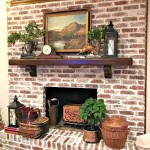The Enduring Appeal of Natural Stone Fireplaces
Natural stone fireplaces represent a timeless architectural feature, adding warmth, beauty, and value to homes. They are more than just a source of heat; they are focal points that evoke a sense of history, craftsmanship, and connection to the natural world. Selecting a natural stone fireplace is a significant decision involving considerations of aesthetics, functionality, and cost. Understanding the various types of stone, their properties, and the installation process is crucial for ensuring a successful and satisfying outcome.
The popularity of natural stone fireplaces stems from their inherent durability, unique aesthetic appeal, and ability to complement a variety of architectural styles. From rustic cabins to modern lofts, a well-designed stone fireplace can enhance the ambiance and create a cozy and inviting atmosphere. Unlike mass-produced fireplaces, each stone fireplace is unique, reflecting the natural variations in color, texture, and pattern that are inherent in the stone itself. This inherent individuality is a significant factor in their enduring appeal.
A Palette of Stone Options: Exploring Different Types of Natural Stone
The range of options available when selecting natural stone for a fireplace is extensive. Each type of stone possesses distinct characteristics that contribute to its overall appearance, performance, and cost. Understanding these differences is essential for making an informed decision.
Granite, known for its exceptional hardness and durability, is a popular choice for fireplace surrounds. Its dense structure makes it resistant to heat, scratches, and stains, making it a practical option for high-traffic areas. Granite is available in a wide array of colors and patterns, ranging from subtle grays and blacks to vibrant reds and blues. Its polished finish adds a touch of elegance and sophistication to any space.
Marble is prized for its luxurious appearance and timeless appeal. With its characteristic veining and smooth texture, marble adds a touch of opulence to any fireplace design. However, marble is more porous than granite and requires careful sealing to prevent staining and damage from acidic substances. While aesthetically beautiful, its higher cost and maintenance requirements should be factored into the decision-making process.
Limestone offers a more rustic and natural look. Its earthy tones and subtle variations in texture create a warm and inviting atmosphere. Limestone is relatively soft and easy to work with, making it a versatile option for creating custom fireplace designs. It is also more porous than granite or marble and requires sealing to protect it from moisture and staining.
Slate is a fine-grained metamorphic rock known for its distinctive layered appearance and natural cleft surface. Its dark, earthy tones and unique texture make it a popular choice for contemporary and rustic fireplace designs. Slate is relatively durable and resistant to heat, making it a practical option for fireplace surrounds. Its natural cleft finish adds a touch of character and authenticity to any space.
Fieldstone, unlike the other options, refers to stones gathered directly from the earth's surface. This option offers a truly rustic and organic appearance, often conveying a sense of history and connection to the surrounding landscape. The irregular shapes and varied sizes of fieldstone create a unique and visually appealing fireplace surround. The cost of fieldstone can vary depending on its availability and the labor required for its installation.
River Rock Similar to fieldstone, river rock provides a natural, textured look, but is comprised of stones that have been smoothed by water. This material provides the natural aesthetic with a smoother, rounder visual. River rock is often chosen for its unique feel and appearance, bringing the outdoors in.
Beyond these common choices, other natural stones such as travertine, soapstone, and quartzite are also used in fireplace construction. The selection process should involve considering the specific design aesthetic, budget, and maintenance requirements of the project.
Design Considerations: Integrating a Stone Fireplace into Your Space
Designing a natural stone fireplace is a multifaceted process that requires careful consideration of several key factors. These include the architectural style of the home, the size and layout of the room, and the desired aesthetic. A well-designed fireplace should seamlessly integrate into the existing space, enhancing its overall appeal and creating a harmonious balance.
The size and scale of the fireplace should be proportional to the dimensions of the room. A large, imposing fireplace may overwhelm a small space, while a small, understated fireplace may get lost in a large room. The height of the mantel and the overall dimensions of the surround should be carefully considered to achieve a balanced and visually appealing design.
The architectural style of the home should also influence the design of the fireplace. In a traditional home, a classic marble or granite fireplace with ornate detailing may be appropriate. In a modern home, a sleek and minimalist slate or limestone fireplace may be a better fit. The goal is to create a cohesive design that complements the existing architecture and enhances the overall aesthetic of the space.
The color and texture of the stone should also be carefully considered. Lighter-colored stones can brighten up a room and create a more airy and spacious feel, while darker-colored stones can add warmth and drama. The texture of the stone can also play a significant role in the overall design. A rough, textured stone can add a rustic and natural feel, while a smooth, polished stone can create a more elegant and sophisticated look.
The style of the hearth is also important. Options include raised hearths, flush hearths, and even cantilevered hearths. The hearth material can be the same as the surround, or a complementary stone to add visual interest. Safety is also paramount. Hearths should extend far enough from the face of the fireplace to protect flooring from sparks and embers.
Beyond the basic structure, additional features such as built-in shelving, decorative lighting, and custom mantels can further enhance the design of the fireplace. These elements can be used to create a more personalized and functional space.
Installation and Maintenance: Ensuring Longevity and Performance
The installation of a natural stone fireplace is a complex and demanding process that requires specialized skills and knowledge. It is crucial to hire a qualified and experienced mason or contractor to ensure that the installation is performed correctly and safely. Improper installation can lead to structural problems, fire hazards, and costly repairs.
The installation process typically involves building a solid foundation to support the weight of the stone, constructing the firebox, and carefully setting each stone in place. The stones are typically adhered to the firebox using a high-temperature mortar. The joints between the stones are then filled with mortar and carefully finished to create a seamless and aesthetically pleasing appearance.
Following the installation, the fireplace should be properly inspected to ensure that it meets all applicable building codes and safety standards. The chimney should also be inspected to ensure that it is properly functioning and free of obstructions.
Regular maintenance is essential for ensuring the longevity and performance of a natural stone fireplace. The specific maintenance requirements will vary depending on the type of stone and the frequency of use. However, some general guidelines include:
*Regularly clean the fireplace surround with a mild detergent and water to remove dust, soot, and other debris.
*Apply a stone sealer to protect the stone from staining and moisture damage. The frequency of sealing will depend on the porosity of the stone and the frequency of use.
*Inspect the mortar joints regularly for cracks or damage and repair as needed. Deteriorated mortar joints can allow water to penetrate the stone, leading to further damage.
*Have the chimney professionally cleaned and inspected annually to remove creosote buildup and ensure proper ventilation. Creosote buildup is a fire hazard.
*Avoid using harsh chemicals or abrasive cleaners on the stone, as these can damage the surface.
*Consider professional cleaning and restoration services periodically to maintain the stone's natural beauty and integrity.
By following these guidelines, homeowners can ensure that their natural stone fireplace remains a beautiful and functional centerpiece of their home for many years to come.
The enduring popularity of natural stone fireplaces stems from their ability to blend beauty, durability, and functionality. A carefully selected and properly installed natural stone fireplace can enhance the ambiance of any space, create a warm and inviting atmosphere, and add lasting value to a home. The investment in a natural stone fireplace is an investment in both the aesthetic appeal and the long-term value of the property.

Why Natural Stone Is The Best Choice For Your Fireplace

Remodel Your Fireplace In Natural Stone Use

Natural Stacked Stone Veneer Fireplace Ideas

5 Reasons To Install A Natural Stone Fireplace Surround

Natural Stone Great Choice New Fireplace Upgrade

Why You Should Use Natural Stone For Your Fireplace Semco Outdoor

Professional Stonework Stone Fireplace Surround Hearths

Stone Fireplace With Natural Hearth Bluestone Natura Fireplaces Remodel

Stone Fireplace Makeover Part 1 Plans Prep Organized Ish

Some Stone Fireplace Surround Ideas You Ll Love Southwest Supply








